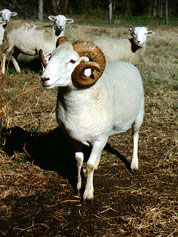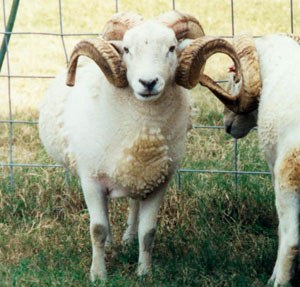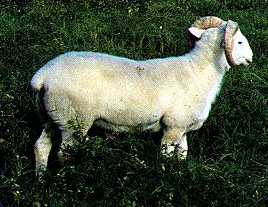Wiltshire Horn Sheep
The Wiltshire Horn is an ancient British breed from the Chalk Downs region of England. Reaching large numbers during the 17th and 18th centuries, they became almost extinct by the beginning of the 20th. A few dedicated breeders persevered with Wiltshires, forming a breed society in 1923. Since the 1970's interest in their unique qualities has increased and by 1982 there were 45 pedigreed flocks in England.
Wiltshire Horn Sheep were exported to Australia in the 1950's and again in the 1970's. They are currently attracting attention for their lack of wool and the need for shearing, as well as their ability to pass on their vitality and quality meat in a cross-breeding program.
A small flock of Wiltshires was exported to the Piel Farm in Canada where they were used to create the modern Katahdin breed. All the Wiltshire in the U.S. came from the Piel flock, and I am aware of only three purebred flocks in this country.
Rams & Ewes
Both rams and ewes are horned. Ewes have a fairly short backward curving horn. Rams horns make a spiral loop each year till they're fully mature, getting thicker and more impressive each year. Occasionally these horns grow too snugly to the rather massive adult jaw and must be cut off. This should be checked for.
Both sexes are white, with occasional dime-sized black spots in the undercoat. They grow a heavy coat of coarse hair for the winter, shedding and rubbing it off as warm weather arrives leaving a short coat of straight hair for summer. The mature ram wears a most handsome "cape" on his chest. Spring shedding starts at the head, going down the back and then the sides. This process may take a couple months, especially as they get adjusted to a new climate. The ewes may keep "pantaloons" on the top of the back legs. Wiltshires are a calm and docile breed. However, the ram horns could be dangerous being right at a child's head level.
Wiltshires are a thrifty breed, doing well on good grass and hay, only needing grain a few weeks before lambing and while nursing. These are medium sized sheep, with a mature ram perhaps 250 lbs, and the ewes about 125-150. They do well in heat, while the heavy winter coat protects well in cold. Woolessness also means no problems with external parasites and they don't need their tails docked.
Lambs & Lambing
Wiltshires wedge shape makes for easy births and the ewes have plenty of milk for twins. They will usually lamb as lambs and the rams can breed at about 7 months. Most of my ewes twin, even as lambs, and mature ewes will have twins weighing about 10 lbs each. The lambs have a lot of vitality and will to live. They are born with protection from cold in the form of a fuzzy coat which they shed at about 45 days.
These lambs don't mature as quickly as some newer breeds, taking almost a year to reach 100-125 lbs slaughter weight on mostly grass. The meat is very desirable, with little fat and a dressing percentage of about 60%.
References
Pat Lenzo, Coffeyville, KS



